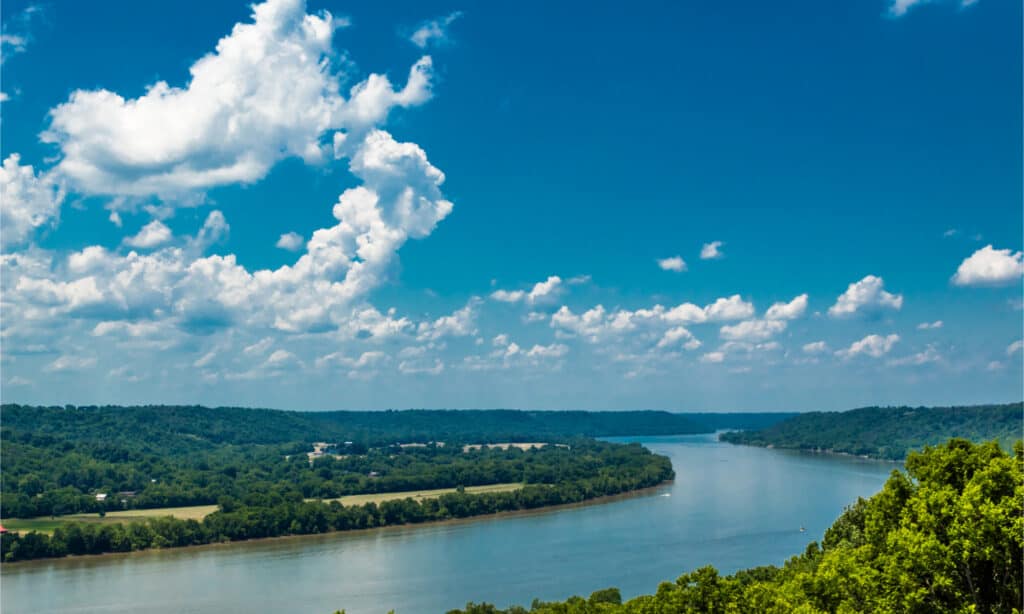Who once called the Ohio River the most beautiful on earth? That’s a good question, since these days it happens to be a badly polluted waterway. However, it remains important to many species of animals as well as to millions of humans. And as one of the longest rivers in the United States, it stands out on the top ten list.
Read on to discover the impressive length of this iconic river!
How Long is the Ohio River?

The Ohio River is 981 miles (1 579 kilometers) long.
©Corey B Stevens/Shutterstock.com
The Ohio River is 981 miles (1,579 kilometers) long. It is the 10th longest river in the United States, just below the Snake River and the Red River. It flows primarily from northeast to southwest. However, it initially dips southward before heading north. Eventually, it resumes its southwestern bent.
The only major obstruction to the river’s flow lies downstream from Louisville, Kentucky. Here lies the Falls of Ohio, a series of rapids making passage nearby impossible. The construction of the McAlpine Locks & Dam solved this problem. This dam allows passage around the rapids and is vital for cargo coming from the Forks of Ohio.
Where Does the Ohio River Start?
This river has two main sources, the Allegheny River and the Monongahela River. The Allegheny passes through Pennsylvania and New York on its way to meet the Monongahela. The Monongahela comes to Pennsylvania through West Virginia. They join at the Forks of Ohio in Pittsburgh, Pennsylvania, and become the Ohio River.
Other tributaries come from several states, namely: New York, Virginia, North Carolina, Tennessee, Maryland, Mississippi, Georgia, and Alabama. Some of these tributaries include:
- Tennessee River
- Cumberland River
- Muskingum River
- Green River
- Wabash River
- Allegheny River
- Kentucky River
- Great Miami River
The Tennessee River is the Ohio River’s largest tributary.
Though the origins of many rivers are disputed, like that of the Mississippi, such a debate generally doesn’t bother the Ohio River.
Where is the Ohio River’s Mouth?
The Ohio River ends at the Mississippi River just south of Cairo, Illinois. It holds the title of the Mississippi’s largest tributary. Flooding at this point has presented a historic challenge to Cairo, which sits on a spit of land at the confluence. However, this danger is alleviated by the Birds Point-New Madrid Floodway. The two rivers resist mixing for several miles downstream.
The Ohio River has a discharge volume of 1.85 million cubic feet per second. By this measurement, it is the third biggest river in the United States.
How Wide is the Ohio River?

The Ohio River’s widest point is a mile long.
©jessica.kirsh/Shutterstock.com
The Ohio River’s widest point spans 1 mile at the Smithland Dam near Smithland, Kentucky. In other places, it is much narrower, such as between the cities of Pittsburgh and Wheeling. Here, it only stretches 0.5 miles.
How Deep is the Ohio River?
The Ohio River plunges to 168 feet at its deepest point near Louisville, Kentucky. This falls short of the deepest river in the United States, the Hudson River, which reaches as deep as 216 feet.
The average depth of the Ohio River is 24 feet. Without the use of dams, it would be a much shallower river than it is today. With the dams in place, it is possible to raise the water levels and control flooding. However, the dams slow the river’s flow significantly and muddy the river. This disturbs the local wildlife and reduces the overall aesthetic appeal.
What States Does the Ohio River Flow Through?

The Ohio River flows through Pennsylvania, West Virginia, Ohio, Kentucky, Illinois, and Indiana.
©ESB Professional/Shutterstock.com
The Ohio River flows through 6 states: Pennsylvania, West Virginia, Ohio, Kentucky, Illinois, and Indiana. Additionally, the Ohio River Basin is home to more than 25 million people, almost 10% of America’s population. This basin covers 490,600 square miles of land and includes water from 14 states.
The river also sustains a number of notable urban centers. Major cities along its banks include Pittsburgh, Cincinnati, Portsmouth, Parkersburg, Wheeling, Louisville, Evansville, Owensboro, Huntington, and Mount Vernon. Historically, the Ohio River is one of the oldest rivers in the world and has been sustaining settlements in the region for thousands of years.
During the Civil War, this river was one of the barriers to freedom for escaping slaves. This earned it the nickname “River Jordan,” as it symbolized the journey to freedom. Many slaves used the Underground Railroad to cross over the Ohio River into the free states. Today, it remains an important north-south dividing line, separating the Mid-western Great Lakes states from those in the South.
What is the Ohio River Used For?
The Ohio River is useful in a number of ways besides sustaining wildlife;
- Drinking water: The river provides drinking water for over 5 million people.
- Dams: 20 dams and locks exist along the Ohio River, used for flood control and navigation.
- Power generating facilities: 38 power generating facilities exist along its banks, making it a vital source of power for millions of people.
- Transportation: 230 million tons of cargo, like coal, oil, and steel, pass down the Ohio River each year.
Is the Ohio River Polluted?

Pollution remains a problem for the Ohio River, which is listed as the most polluted river in the United States.
©Nat Chittamai/Shutterstock.com
Thomas Jefferson once said that the Ohio River was the most beautiful river on earth. He said this without ever having seen it, but it may have had some merit. The name Ohio comes from the Seneca word Ohi:yo, meaning “good river” or “beautiful river.” Before the Industrial Revolution, the Ohio River may indeed have been lovely.
However, that is no longer the case. Today, the Ohio River is considered the most polluted in the United States. Why is this?
How Did the Ohio River Get So Polluted?
First of all, industrialization has caused most of the pollution. Traders have long used the Ohio River as a trade route, with urban centers springing up along its banks. Over time, this has taken its toll. Perhaps the biggest impact is from the steel industry, which continually dumps mercury and nitrate compounds into the water. Unless the steel industry significantly changes its practices, it is unlikely the Ohio River will be cleaned up any time soon.
Secondly, algae bloom is a problem. Power plants cause this by dumping nitrates and phosphates into the water. Again, without a change in business practices, the algae will only continue to spread.
Thirdly, the river is also a dumping ground for raw sewage and acid mine drainage. This endangers many species like mussels that depend on the Ohio River for survival.
As polluted as the Ohio River is, it remains a vital resource for the humans who live along its banks. With care, this lengthy American river will continue to provide important benefits and perhaps even regain its natural beauty.
The photo featured at the top of this post is © jessica.kirsh/Shutterstock.com
Thank you for reading! Have some feedback for us? Contact the AZ Animals editorial team.







